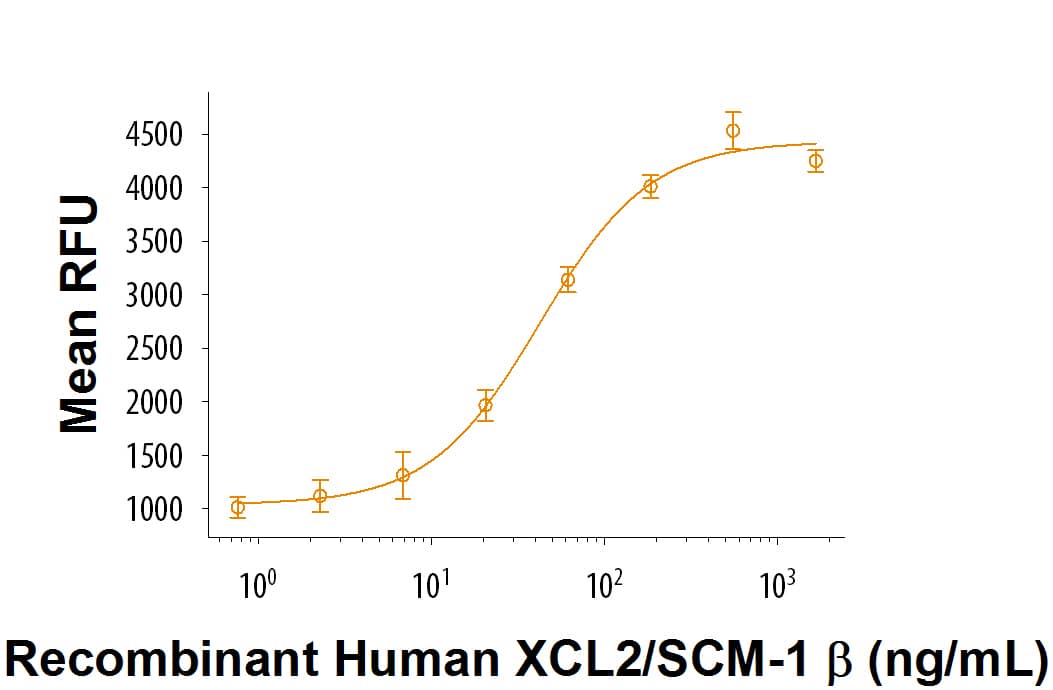Recombinant Human XCL2/SCM-1 beta Protein
R&D Systems, part of Bio-Techne | Catalog # 8418-X2

Key Product Details
Product Specifications
Source
Val22-Gly114
Purity
Endotoxin Level
N-terminal Sequence Analysis
Predicted Molecular Mass
SDS-PAGE
Activity
The ED50 for this effecy is 10-60 ng/mL.
Scientific Data Images for Recombinant Human XCL2/SCM-1 beta Protein
Recombinant Human XCL2/SCM-1 beta Protein Bioactivity
Recombinant Human XCL2/SCM-1 beta (Catalog # 8418-X2) chemoattracts BaF3 mouse pro B cells transfected with human XCR1. The ED50 for this effect is 10-60 ng/mL.Formulation, Preparation and Storage
Carrier Free
What does CF mean?CF stands for Carrier Free (CF). We typically add Bovine Serum Albumin (BSA) as a carrier protein to our recombinant proteins. Adding a carrier protein enhances protein stability, increases shelf-life, and allows the recombinant protein to be stored at a more dilute concentration. The carrier free version does not contain BSA.
What formulation is right for me?In general, we advise purchasing the recombinant protein with BSA for use in cell or tissue culture, or as an ELISA standard. In contrast, the carrier free protein is recommended for applications, in which the presence of BSA could interfere.
Carrier: 8418-X2
| Formulation | Lyophilized from a 0.2 μm filtered solution in PBS with BSA as a carrier protein. |
| Reconstitution | Reconstitute at 250 μg/mL in sterile PBS containing at least 0.1% human or bovine serum albumin.
|
| Shipping | The product is shipped at ambient temperature. Upon receipt, store it immediately at the temperature recommended below. |
| Stability & Storage | Use a manual defrost freezer and avoid repeated freeze-thaw cycles.
|
Carrier Free: 8418-X2/CF
| Formulation | Lyophilized from a 0.2 μm filtered solution in PBS. |
| Reconstitution | Reconstitute at 250 μg/mL in sterile PBS. |
| Shipping | The product is shipped at ambient temperature. Upon receipt, store it immediately at the temperature recommended below. |
| Stability & Storage | Use a manual defrost freezer and avoid repeated freeze-thaw cycles.
|
Background: XCL2/SCM-1 beta
Human XCL2 (also known as Lymphotactin-2, SCYC2, and SCM-1 beta) is a 10 kDa glycosylated protein in the C chemokine family (1-3). XCL1/Lymphotactin is a closely related chemokine that differs from XCL2 by only two amino acids (aa). Human XCL2 encodes a 114 amino acid aa precursor protein with a 21 aa predicted signal peptide. Members of the C chemokine family lack two (the 1st and 3rd) of the four invariant cysteine residues normally found in the CC and CXC chemokines. They also have an extended carboxy terminus (4). XCL1/Lymphotactin which is expressed in activated T cells and NK cells, while certain stimulatory conditions have been shown to induce XCL2 expression in macrophages (5-7). XCL2 and XCL1/Lymphotactin bind and activate the G protein-coupled receptor, XCR1. XCR1 is expressed on dendritic cells, T lymphocytes, and B lymphocytes (8-11). Binding of XCL2 to XCR1 initiates chemotaxic cell migration in dendritic cells as well as in T and B lymphocytes. XCR1 is also expressed on ovarian carcinoma cells and may contribute to cancer cell migration and proliferation in response to XCL2 or XCL1/Lymphotactin (12).
References
- Yoshida, T. et al. (1996) FEBS Lett. 395:82.
- Kelner, G.S. et al. (1994) Science 266:1395.
- Muller, S. et al. (1995) Eur. J. Immunol. 25:1744.
- Yoshida, T. et al. (1995) FEBS Lett. 360:155.
- Hedrick, J.A. et al. (1997) J. Immunol. 158:1533.
- Luzi, G. et al. (2007) Clin. Immunol. 125:127.
- Cao, W. et al. (2008) Curr. Microbiol. 57:189.
- Kroczek, R.A. and V. Henn (2012) Front. Immunol. 3:14.
- Huang, H. et al. (2001) Biochem. Biophys. Res. Commun. 281:378.
- Pigard, N. et al. (2009) J. Neuroimmunol. 209:114.
- Yamazaki, C. et al. (2010) Biochem. Biophys. Res. Commun. 397:756.
- Kim, M. et al. (2012) Mol. Cancer. Res. 10:1419.
Long Name
Alternate Names
Entrez Gene IDs
Gene Symbol
UniProt
Additional XCL2/SCM-1 beta Products
Product Documents for Recombinant Human XCL2/SCM-1 beta Protein
Product Specific Notices for Recombinant Human XCL2/SCM-1 beta Protein
For research use only
